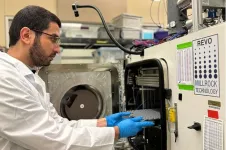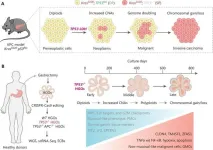(Press-News.org) PROVIDENCE, R.I. [Brown University] — A new analysis revealed the frequency of potentially lethal substances, such as fentanyl and xylazine, in counterfeit pills that had been circulating in Rhode Island’s illicit drug supply.
Study author Dr. Rachel Wightman, an associate professor of epidemiology and emergency medicine at Brown University, said the analysis provides important information about the composition of counterfeit pills, which are designed to replicate legitimate pharmaceutical pills but often lead to adverse health effects.
“The level of detail found in our analysis can help inform treatment conversations and improve patient care,” said Wightman, a physician who cares for patients seeking help for opioid use disorder.
The analysis was published in the Journal of the American Medical Association.
Wightman said that most knowledge of counterfeit pills comes from community drug-checking initiatives or broad government reports with limited data. Comprehensive lab testing is an important complement to identify the range of substances found in counterfeit pills, she said.
Data for the analysis was obtained from law enforcement drug seizures reported by the Rhode Island Department of Health from 2017 to 2022. A total of 1,176 counterfeit pills were tested and classified into five categories: oxycodone, alprazolam, amphetamine/dextroamphetamine, clonazepam and unknown. The researchers found that in 2022, 99.3% of counterfeit oxycodone prescription pills contained fentanyl, a powerful synthetic opioid that is a major contributor to overdoses in the U.S., and 67% contained para-fluorofentanyl, an illicit fentanyl analog.
“Any pill not from a pharmacy may contain fentanyl,” Wightman said.
Even if fentanyl is not present, Wightman said, it is important for health professionals treating patients to understand the contents of counterfeit prescription pills, as the effects of active ingredients may be different than the prescription pills they mimic, thus requiring different treatment approaches.
In 2022, the active substance xylazine, a powerful sedative that has been implicated in the national overdose crisis, was detected in almost 40% of counterfeit oxycodone pills, always alongside fentanyl, the study found. According to the analysis, counterfeit pills often contained methamphetamine or novel benzodiazepines, such as bromazolam, which, like xylazine, are not approved for human use.
“Novel substances can be challenging in overdoses as results from biological testing will not be available in time to guide acute management,” Wightman said. “Furthermore, withdrawal management and substance use treatment are complicated by irregular doses and contents. So having a baseline knowledge of what is in the unregulated drug supply can be very helpful.”
Testing of the seized counterfeit pills was performed via comprehensive gas chromatography and mass spectrometry screening at the Rhode Island Department of Health Laboratories in Providence.
“This retrospective is a nice proof of concept on how impactful the findings can be,” said study author Glen Gallagher, the director of the state health laboratories. “We are taking steps to make the data more readily available so that community partners can be aware of what’s on the street in real time and can help communicate that information to people who use drugs as well as those who treat them, to hopefully mitigate risks.”
This report is one of the first times a comprehensive analysis of counterfeit pills in the unregulated drug supply has been widely shared, the researchers said.
“Part of our goal with this report is to encourage other states as well as the federal government to release this type of data and information to the public,” Wightman said.
Study contributors included Leslie Nolan and Ben Hallowell at the Rhode Island Department of Health; Bryan Volpe of the HIDTA New England Overdose Task Force; and Thomas Chadronnet of the CDC Foundation. The research was supported in part by the U.S. Centers for Disease Control and Prevention.
END
Study provides comprehensive analysis of Rhode Island’s unregulated drug supply
An analysis of drugs seized by law enforcement agencies revealed the frequency of potentially lethal substances, including fentanyl, in counterfeit pills
2024-05-07
ELSE PRESS RELEASES FROM THIS DATE:
Biomarker found to help identify cells that can repair damaged blood vessels
2024-05-07
INDIANAPOLIS – Researchers have discovered a protein marker to help identify cells able to repopulate in patients with damaged blood vessels. Their findings, recently published in Circulation, could lead to new therapies for people with endothelial dysfunction, a type of disorder that contributes to coronary artery disease that may occlude with plaque and lack ability to carry sufficient blood into the heart tissue causing a heart attack.
“This study is the first to establish that a single, prospective marker identifies vascular clonal repopulating endothelial cells ...
Could getting enough sleep help prevent osteoporosis?
2024-05-07
As part of the University of Colorado Department of Medicine’s annual Research Day, held on April 23, faculty member Christine Swanson, MD, MCR, described her National Institutes of Health-funded clinical research on whether adequate sleep can help prevent osteoporosis.
“Osteoporosis can occur for many reasons such as hormonal changes, aging, and lifestyle factors,” said Swanson, an associate professor in the Division of Endocrinology, Metabolism, and Diabetes. “But some patients I ...
LyoWave licenses Purdue freeze-drying innovations, enters collaboration with Millrock Technology
2024-05-07
WEST LAFAYETTE, Ind. — LyoWave Inc., a high-tech startup, is commercializing innovative microwave heating technologies developed at Purdue University that improve upon traditional lyophilization — or the process of freeze-drying perishable products — by increasing speed, cost-effectiveness and product throughput.
CEO and co-founder Drew Strongrich said LyoWave’s microwave energy innovations open new possibilities for a variety of products.
“Our technology overcomes the historic issues associated with microwave systems such as nonuniform heating, poor ...
CU Center for COMBAT Research and United States Air Force Academy form educational partnership
2024-05-07
Cheers erupted from a crowd gathered at the University of Colorado Anschutz Medical Campus on April 19 as leaders at the CU School of Medicine and the United States Air Force Academy (USAFA) signed an educational partnership agreement, a historic moment that will open a breadth of opportunities for both institutions.
“This is a very happy occasion for us and formalizes something that we always seek to have, which is a mutually beneficial partnership with colleagues in the state,” said John J. Reilly Jr., MD, dean ...
Road of no return — loss of TP53 paves a defined evolution path from gastric preneoplasia-to-cancer
2024-05-07
“The independent research groups, led by Prof. Scott W. Lowe and Christina Curtis,respectively, have uncovered a similar definitive pathway in the progression of gastric cancer (GC) initiated with loss of the TP53 gene, representing a milstone in understanding the early stages of this deadly disease”. Dr. Zhaocai Zhou, head of a GC laboratory from Fudan University, stated.“Their study offers detailed insights into how genetic changes drive the transformation from preneoplastic conditions to full-blown cancer. Their findings revealed that loss of TP53 is not merely a common genetic anomaly but a pivotal event that propels ...
Navigating the risks: safeguarding maternal and fetal health in emergency agitation treatment
2024-05-07
A recent review article provides critical insights into the management of acute agitation in reproductive-age females and during pregnancy within the emergency departments (EDs). The study emphasizes the importance of considering the safety of psychotropic medications in this demographic population, given the potential risks to both the patient and the fetus.
Agitation in the emergency department is not uncommon and can stem from various causes, including psychiatric disorders, substance abuse, and other medical ...
Telehealth program created to improve access to specialty care found to reduce reliance on opioids in pain management
2024-05-07
COLUMBIA, Mo. (May 7, 2024) ― More Americans suffer from chronic pain than diabetes, heart disease, and cancer combined. Yet, a shortage of pain medicine specialists persists, causing many pain sufferers to seek care in primary care settings.
Researchers from the University of Missouri School of Medicine have found that an innovative tele-mentoring program can help address reliance on opioids in the management of pain, with potential benefits for patients, families and communities.
Project Extension for Community Healthcare Outcomes (ECHO) is an innovative educational and mentoring model where ...
Advancing satellite-based PNT service: low earth orbit satellite constellations augment the GNSS
2024-05-07
A study has outlined the critical needs and essential technologies for a Low Earth Orbit (LEO) constellation to augment satellite navigation systems, significantly improving the Positioning, Navigation and Timing (PNT) services. This research specifically targets the diverse demands of different users for LEO augmented GNSS, the possible contribution of LEOs to PNT performances, and the key technologies referring to the LEO-based navigation augmentation system.
The Global Navigation Satellite Systems (GNSS), including the BeiDou Navigation Satellite System (BDS), are the most widely used in providing PNT services. However, GNSS signals from geostationary orbit (GEO), inclined ...
Researchers show that slow-moving earthquakes are controlled by rock permeability
2024-05-07
Earthquakes are the most dramatic and noteworthy results of tectonic plate movement. They are often destructive and deadly, or at the very least physically felt — they’re literally groundbreaking geological events. However not all tectonic movement results in effects that humans can perceive.
Slow slip events occur when pent up tectonic forces are released over the course of a few days or months, like an earthquake unfolding in slow motion. The more gradual movement means people won’t feel the earth shaking beneath their feet and buildings won’t collapse. But the lack of destruction does not make slow slip events less scientifically ...
Seeking medical insights in the physics of mucus
2024-05-07
WASHINGTON, May 7, 2024 – As much as we might not want to think about it, mucus is everywhere in our bodies. It coats our airways and our digestive systems and serves as a first line of defense against pathogens, a habitat for our microbiomes, and a conveyor belt for our insides to keep everything moving smoothly.
The front-line role of mucus means it is often the site of the first symptoms of infection or disease. Understanding how mucus changes, and what it changes in response to, can help diagnose illnesses and develop treatments. Designing a study to measure the physical properties of mucus, however, is nothing to sneeze at.
In APL Bioengineering, by AIP Publishing, ...
LAST 30 PRESS RELEASES:
Post-stroke injection protects the brain in preclinical study
Cardiovascular risk score predicts multiple eye diseases
Health: estimated one in ten British adults used or interested in GLP-1 medications for weight loss
Exercise to treat depression yields similar results to therapy
Whooping cough vaccination for pregnant women strengthens babies’ immune system
Dramatic decline in new cases of orphanhood in Uganda driven by HIV treatment and prevention programs
Stopping weight loss drugs linked to weight regain and reversal of heart health markers
Higher intake of food preservatives linked to increased cancer risk
Mass General Brigham–developed cholera vaccine completes phase 1 trial
First experimental validation of a “150-year-old chemical common sense” direct visualization of the molecular structural changes in the ultrafast anthracene [4+4] photocycloaddition reaction
Lack of support for people on weight loss drugs leaves them vulnerable to nutritional deficiencies, say experts
Dogs’ dinners can have greater climate impact than owners’
Are you ready to swap salmon for sprats and sardines?
1.6 million UK adults used weight loss drugs in past year
American College of Cardiology comments on new dietary guidelines for Americans
American Society of Gene & Cell Therapy and Orphan Therapeutics Accelerator partner to advance and commercialize promising rare disease treatments
One in 14 patients having day case surgery have new or worse chronic pain 3 months after their operation
New study highlights link between eviction rates and gun violence
Heatwaves heat up soil but not toxin levels in rice, study finds
Digital modeling reveals where construction carbon emissions really come from
Turning farm waste into water filters
New study shows how the spleen helps the immune system accept a transplant
New Mayo Clinic study advances personalized prostate cancer education with an EHR-integrated AI agent
Researchers identify novel therapeutic target to improve recovery after nerve injury
Microbes in breast milk help populate infant gut microbiomes
Reprogramming immunity to rewrite the story of Type 1 diabetes
New tool narrows the search for ideal material structures
Artificial saliva containing sugarcane protein helps protect the teeth of patients with head and neck cancer
Understanding the role of linear ubiquitination in T-tubule biogenesis
Researchers identify urban atmosphere as primary reservoir of microplastics
[Press-News.org] Study provides comprehensive analysis of Rhode Island’s unregulated drug supplyAn analysis of drugs seized by law enforcement agencies revealed the frequency of potentially lethal substances, including fentanyl, in counterfeit pills




